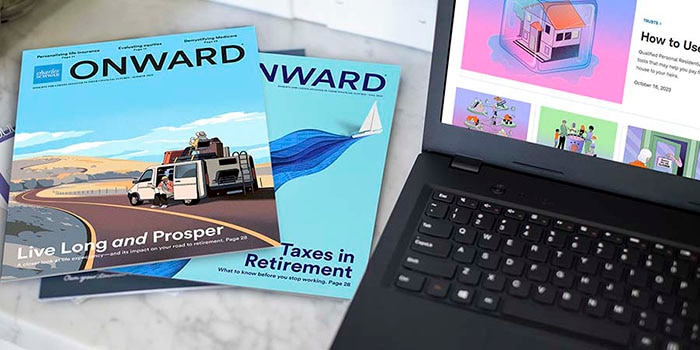
During your working years, your employer typically withholds income tax on your behalf, helping to avoid underpayment penalties come Tax Day. But when you get to retirement, you generally have multiple income sources that may or may not have the appropriate taxes withheld, leaving you to pay estimated taxes throughout the year.
"If you don't make adequate estimated tax payments, you could face a big tax bill and potential penalties when you file your taxes," says Hayden Adams, CPA, CFP®, director of tax and wealth management at the Schwab Center for Financial Research, who worked for eight years as a senior auditor for the IRS.
Here are four questions to help new and soon-to-be retirees determine their federal tax obligations—and how to satisfy them going forward.
1. What are your sources of retirement income?
Generally speaking, retirees' taxable income sources will fall under one of two federal tax categories:
- Ordinary income, which is taxed from 10% to 37% and includes:
- Wages paid by an employer
- Interest payments (excluding those from tax-free municipal bonds)
- Ordinary dividends
- Short-term capital gains (on assets held a year or less)
- Taxable withdrawals from retirement accounts1
- Taxable Social Security benefits
- Withdrawals from health savings accounts (HSAs) for nonqualified expenses2
- Annuity payouts3
- Rental income
- Pension payouts
- Long-term capital gains, which are taxed at 0%, 15%, or 20%, depending on your total taxable income, and generally include profits from the sale of a business, real estate,4 securities, and most other assets held longer than a year, as well as qualified dividends.
What's more, if your modified adjusted gross income is $200,000 or more as a single filer or $250,000 or more as a married couple filing jointly, you'll face an additional 3.8% net investment income tax (NIIT) on income generated from investment assets, which generally include interest, dividends, long- and short-term capital gains, rental and royalty income, and nonqualified annuities.
"It's not uncommon for today's retirees to have five or more sources of income," Hayden says. "However, the more sources you have, the more challenging it can be to figure out exactly what you'll owe and how much to withhold."
2. How much are you withholding?
To complicate matters, taxes are automatically withheld from some income sources but not from others—and the amounts withheld may not satisfy your actual tax liability. For example:
- 401(k), 403(b), and other qualified workplace retirement plans: Generally, most withdrawals are subject to 20% withholding. However, withdrawals made to satisfy your annual required minimum distributions (RMDs) are subject to 10% withholding, which for high-income retirees may be far too low. For example, a single 73-year-old retiree with a $2.5 million IRA would face an RMD of $94,340 this year, placing them squarely in the 22% tax bracket even before accounting for other income.
- Annuities and pensions: Taxable, periodic (i.e., regular) payments from annuities and pensions are treated as ordinary income, and taxes are withheld according to the IRS withholding tables in IRS Publication 15-T.
- Social Security: Depending on your combined income—which includes your adjusted gross income, tax-exempt interest income, and half your Social Security benefits—up to 85% of your total Social Security benefits could be taxable. However, the Social Security Administration (SSA) won't withhold taxes unless you submit a request for it to do so. Withholding rates are fixed: 7%, 10%, 12%, or 22%.
- Taxable bank or brokerage accounts: In most instances, taxes are not withheld from realized capital gains, dividends, or other income generated from such accounts. "If you'll draw a significant portion of your income from these sources, you'll need to either have more taxes withheld from other income sources or pay quarterly estimated taxes," Hayden says (see "What's your payment plan?").
- Traditional, SEP, and SIMPLE IRAs: Unless you specify otherwise, your plan's custodian will withhold just 10% of your taxable distributions.
To set up or change your withholding
- 401(k), 403(b), and other qualified workplace retirement plans: To set up or change your withholding for nonperiodic5 withdrawals, submit Form W-4R to your plan administrator.
- Annuities and pensions: To set up or change your withholding for periodic6 payments, submit Form W-4P to the payer.
- Social Security: To set up or change your withholding, submit Form W-4V to your local SSA office.
- Traditional, SEP, and SIMPLE IRAs: To set up or change your withholding for nonperiodic7 withdrawals, submit Form W-4R to your plan administrator.
3. What do you owe?
If you're newly retired, figuring out your tax bill for the first time can feel intimidating, especially because there's no IRS calculator or tool to ensure success.
That said, several online resources exist to help estimate your taxes. AARP, for example, has a robust tax calculator that uses your income, filing status, deductions, and credits to gauge your total taxes for the year. Likewise, most of the major tax preparation companies also offer free online tools to help you estimate your tax bill.
"These resources can be a great jumping off point," Hayden says, "but it's wise to enlist the help of a professional, especially in the first few years of retirement. Not only can they help you calculate your tax liability, but they can also suggest ways to minimize it now and in the future."
4. What's your payment plan?
Once you know how much you'll likely owe in taxes for the year, you'll next need to determine how to pay it. Generally speaking, you have two options:
- Adjust your withholding: This is perhaps the easiest approach. "Once you've established the necessary withholding amounts from the accounts that allow for it, it's pretty much set it and forget it until the next tax year," Hayden says. For example, if your estimated total tax liability is $30,000 and you plan to withdraw $100,000 from your 401(k) over the course of the year, you could simply withhold 30% of each 401(k) distribution. "Paying all your taxes from a single income source can make it easier to track, as well as offset any sources of income that don't withhold the necessary taxes," Hayden says. "Just be sure to update your other withholding amounts to 0% so you don't end up giving the IRS too much."
- Make quarterly estimated payments: You may have to make quarterly estimated payments if you realize unexpected income, have significant rental or taxable investment income, or are self-employed. If you don't make estimated payments to satisfy your extra tax liability, you could face an underpayment penalty. "As with calculating your overall tax liability, calculating your estimated payments can take some work, so it could make sense to enlist the aid of a tax professional," Hayden says.
To calculate your estimated taxes, see Form 1040-ES.
The very good news
Once you've made it through your first year of retirement, the IRS offers a shortcut for future years: You can avoid penalties and having to recalculate your tax liability each year simply by withholding 100% of last year's taxes if your adjusted gross income (AGI) is $150,000 or less, or 110% of last year's taxes if your AGI is more than $150,000 ($75,000 for individuals or married couples filing separately).
"For those who expect their income to be similar to the previous tax year, it's a great way to avoid the hassle of calculating it all again from scratch," Hayden says. "It won't be perfect—you might still owe a bit of tax or be due a refund—but the goal here isn't perfection, it's simplicity. After all, who wants to spend more time than absolutely necessary worrying about taxes?"
1Excludes withdrawals from Roth accounts, which are tax-free if you're 59½ or older and the account has been open for at least five years.
2At age 65, you can take penalty-free distributions from your HSA for any reason. Prior to age 65, nonqualified withdrawals may incur a 20% penalty.
3All or a portion of an annuity payout may be taxable depending on whether the annuity was purchased with pretax or posttax funds.
4You may be able to exclude the first $250,000 in gains ($500,000 if married) from your tax liability if the property was your primary residence for at least two of the past five years.
5, 6, 7To determine whether a withdrawal is considered periodic or nonperiodic, see the IRS's Pensions and Annuity Withholding guidelines.
Discover more from Onward

Keep reading the latest issue online or view the print edition.
The information provided here is for general informational purposes only and should not be considered an individualized recommendation or personalized investment advice. The investment strategies mentioned here may not be suitable for everyone. Each investor needs to review an investment strategy for his or her own particular situation before making any investment decision.
All expressions of opinion are subject to change without notice in reaction to shifting market conditions. Data contained herein from third-party providers is obtained from what are considered reliable sources. However, its accuracy, completeness, or reliability cannot be guaranteed.
Examples provided are for illustrative purposes only and not intended to be reflective of results you can expect to achieve.
The information provided here is for general informational purposes only and is not intended to be a substitute for specific individualized tax, legal, or investment planning advice. Where specific advice is necessary or appropriate, consult with a qualified tax advisor, CPA, financial planner, or investment manager.
Investing involves risk including loss of principal.
Tax-exempt bonds are not necessarily a suitable investment for all persons. Information related to a security's tax-exempt status (federal and in-state) is obtained from third parties, and Schwab does not guarantee its accuracy. Tax-exempt income may be subject to the Alternative Minimum Tax (AMT). Capital appreciation from bond funds and discounted bonds may be subject to state or local taxes. Capital gains are not exempt from federal income tax.
The Schwab Center for Financial Research is a division of Charles Schwab & Co., Inc.
0823-3Y8G

